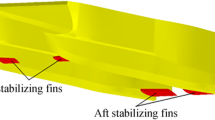Abstract
Wave-piercing design is a revolution in hull design for small high-speed boats to operate in adverse sea conditions. To study hydrodynamics of the small high speed wave piercing monohull craft systematically, four typical small high-speed wave-piercing monohull crafts were developed, and validated CFD methods were adopted to calculate hull resistances and motions. The resistances and hull motions of these high-speed wave piercing monohull crafts in calm water and waves were obtained and compared. Obvious operating differences can be observed. High-speed wave piercing monohull crafts with slender and twisted planing hulls have smaller resistance at high speed, but the dynamic effects increase as sea conditions worsen. The high-speed wave-piercing monohull craft with a slim multi-chine hull maintains in waves for softer hull motions but suffers the disadvantages of larger resistance. The high-speed wave piercing monohull craft with a triangular hull shows no obvious advantages compared with the other types.
Similar content being viewed by others
Reference
Payne P. High speed boat with planing hull: U.S. Patent 3763810 [P]. 1973.
Thompson A. Boat: US, Patent 6116180 [P]. 2000.
Seo J., Choi H. K., Jeong U. C., et al. Model tests on resistance and seakeeping performance of wave-piercing high-speed vessel with spray rails [J]. International Journal of Naval Architecture and Ocean Engineering, 2016, 8(5): 442–455.
Wei C.,Mao L.,LI Y.,et al.: Analysis of the hull form and sailing characters in calm water of a semi-planing wave-piercing boat [J]. Chinese Journal of Ship Research, 2015, 10(5): 16–21 (in Chinese).
Calderon A., Hedd L. Theoretical Considerations and Experimental Investigation of Seakeeping of Transonic Hulls [C]. Proceedings of the 11th International Conference on Fast Sea Transportation. Hawaii, USA, 2011, 763–771.
Wei C., Li Y., Yu S., et al. Experimental study on the high speed mono-wave-piercing boat [J]. Journal of Shanghai Jiaotong University (Science), 2016, 21(5): 524–529.
Wei C., Yi H., Li Y. Influence of bowshape on hydrodynamic performance of mono wave-piercing craft [J]. Journal of Shanghai Jiaotong University, 2018, 52(3): 268–275(in Chinese).
Larsson L., Stern F., and Visonneau M. Numerical Ship Hydrodynamics–An assessment of the Gothenburg 2010 Workshop [M]. Springer, The Netherlands, 2014.
Yousefi R., Shafaghat, R., Shakeri, M. High-speed planing hull drag reduction using tunnels [J]. Ocean Engineering, 2014, 84: 54–60.
Qian P., Yi H., Li Y. Numerical and experimental studies on hydrodynamic performance of a small-waterplane-area-twin-hull (SWATH) vehicle with inclined struts [J]. Ocean Engineering, 2015, 96: 181–191.
De Marco A., Mancini S., Miranda S., et al. Experimental and numerical hydrodynamic analysis of a stepped planing hull [J]. Applied Ocean Research, 2017, 64: 135–154.
Cucinotta F., Guglielmino E., Sfravara F. et al. Numerical and experimental investigation of a planing air cavity ship and its air layer evolution [J]. Ocean Engineering, 2018, 152: 130–144.
Kavli H. P., Oguz E., Tezdogan T. A comparative study on the design of an environmentally friendly RoPax ferry using CFD [J]. Ocean Engineering, 2017, 137: 22–37.
Menter F. R. Two-equation eddy-viscosity turbulence models for engineering applications [J]. AIAA journal, 1994, 32(8): 1598–1605.
Hirt C. W., Nichols B. D. Volume of fluid (VOF) method for the dynamics of free boundaries [J]. Journal of computational physics, 1981, 39(1): 201–225.
Fenton J. D. A fifth-order Stokes theory for steady waves [J]. Journal of waterway, port, coastal, and ocean engineering, 1985, 111(2): 216–234.
Clark, C. G., Lyons, D. G., Neu, W. L. Comparison of single and overset grid techniques for CFD simulations of a surface effect ship [C]. ASME 2014 33rd International Conference on Ocean, Offshore and Arctic Engineering. San Francisco, USA, 2014, 1–7.
Sun X. S., Yao C. B., Xiong Y. et al. Numerical and experimental study on seakeeping performance of a SWATH vehicle in head waves [J]. Applied Ocean Research, 2017, 68: 262–275.
Frisk D., Tegehall L. Prediction of high-speed planing hull resistance and running attitude [D]. Master Thesis, Sweden: Chalmers University of Technology, 2009.
Wei C., Li Y., Yi H. Application of polyhedral mesh in numerical simulations of flow around hulls [J]. Journal of Shanghai Jiaotong University, 2016, 50(8): 1144–1151 (in Chinese).
Çakici F., Sukas Ö. F., Usta O., et al. A computational investigation of a planing hull in calm water by U-RANSE approach [C]. International conference on advances in applied and computational mechanics. Izmir, Turkey, 2015, 1–10.
Taunton D. J., Hudson D. A., Shenoi, R. A. Characteristics of a series of high speed hard chine planing hulls-part 1: performance in calm water [J]. International Journal of Small Craft Technology, 2010, 152: 55–75.
Van’t Veer R. Experimental results of motions, hydrodynamic coefficients and wave loads on the 372 Catamaran model [R]. Delft University of Technology, Delft University Report 1129, 1998.
Acknowledgements
This work was supported by a foundation of State Key Laboratory of Ocean Engineering, Shanghai Jiao Tong University (Grant No. GKZD010061).
Author information
Authors and Affiliations
Corresponding author
Additional information
Biography: Cheng-zhu Wei (1987-), Male, Ph. D.
Rights and permissions
About this article
Cite this article
Wei, Cz., Li, Yh., Liang, Xf. et al. Hull forms of small high-speed wave-piercing monohull crafts and hydrodynamics study. J Hydrodyn 31, 814–826 (2019). https://doi.org/10.1007/s42241-018-0173-8
Received:
Revised:
Accepted:
Published:
Issue Date:
DOI: https://doi.org/10.1007/s42241-018-0173-8




